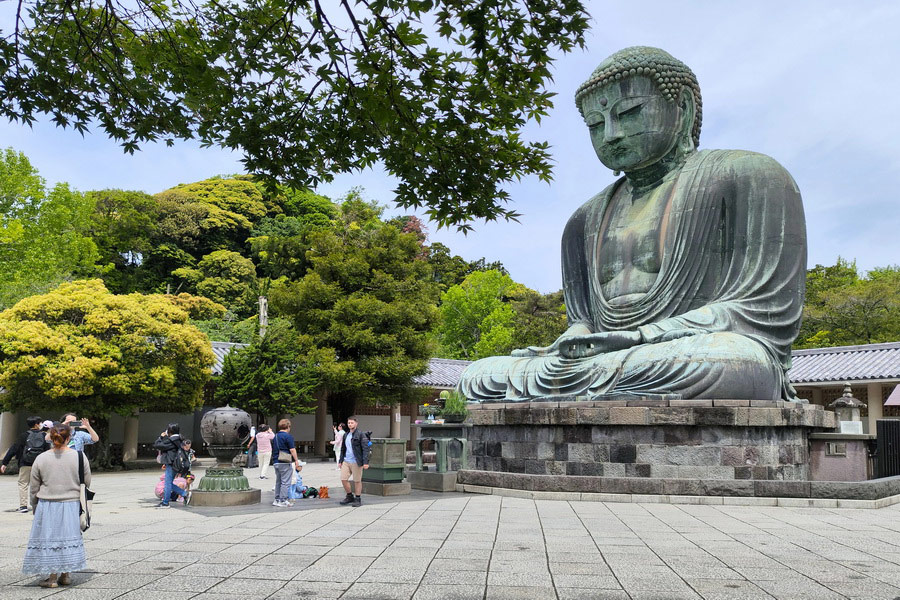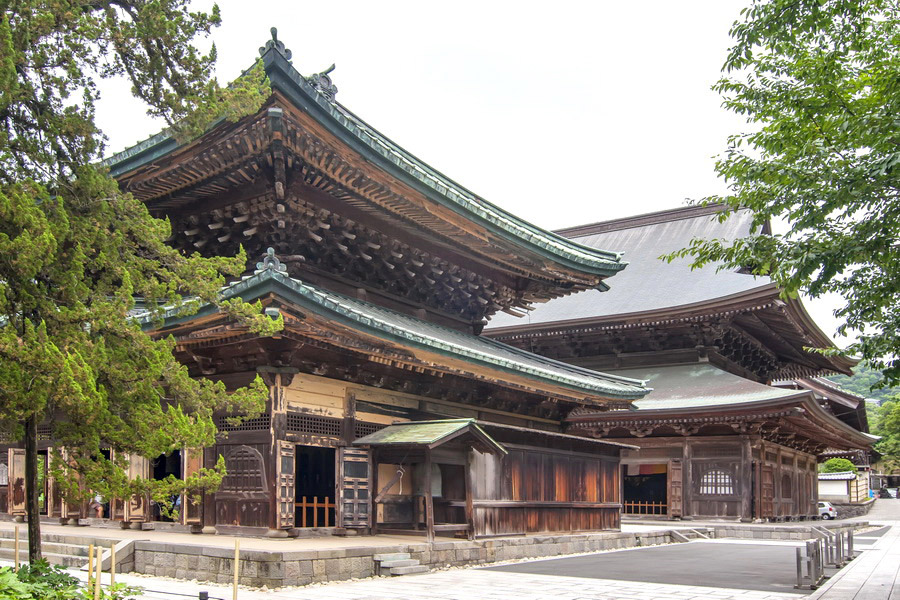
Kamakura hiking takes you along ancient trails that preserve the area's rich history and culture in its original form.
Walking through the hills of this historic city offers the chance to admire its beauty, visit hidden temples tucked into the mountains, and escape the hustle and bustle of urban life.
Kamakura hiking is also perfect for building stamina, with many trails being long and challenging, ranking among the most popular long distance hiking trails in Japan.
Main Trails
If you look at the map of Kamakura (Japan), you'll notice the town is surrounded by hills on three sides. Historically, access to Kamakura was possible via seven main mountain trails, known as Kiridoshi (切通し), or the Gate of Kamakura.
Today, these historic mountain paths form the foundation for the main hiking trails in Kamakura. The most notable trails include:
- Daibutsu Road (大仏路)
- Tenen Road (天園路)
- Asahina Road (朝比奈路)
which guide hikers through many of the city's key attractions.
Additionally, less popular but equally scenic options include:
- Rokkokukenzan Course (六国見山コース)
- Gionyama Course (祇園山コース)
- Kinubari Nagoe Kiridoshi (衣張り長尾切通し).
Daibutsu Road
The Daibutsu Road (大仏路) is the most popular route in Kamakura, as it passes through the city's main attraction, the 11-meter-high Great Buddha statue (大仏), which gives the route its name.
The Daibutsu route connects Kita Kamakura Station (北鎌倉駅) and Kotoku-in Temple (高徳院), spanning approximately 6 kilometers and taking about 1.5 hours to complete.
Along the way, you’ll encounter notable sights such as:
- Jochi-ji Temple (浄智寺). A small Zen Buddhist temple built in the 13th century, famous for its mysterious caves open to the public.
- Kuzuharaoka Shrine (葛原岡神社). A Shinto temple from the late 19th century dedicated to Hino Toshimoto (日野俊基), a 14th-century courtier who is considered the patron saint of good luck. On the shrine grounds, you’ll find the Grave of Hino Toshimoto (日野俊基の墓) and the "demon leaving stone" (魔去石). Throwing a cup at the stone is believed to banish evil spirits and bring good luck.
- The shrine complex also features the enmusubi-ishi (縁結石), two stones symbolizing a man and a woman in love, said to bring good fortune in love and marriage.
- Kotoku-in Temple (高徳院) and the Great Buddha statue (大仏). According to legend, this temple was initiated by Yoritomo Minamoto (源頼朝) in the 12th century, inspired by the Great Buddha at Todaiji temple (東大寺) in Nara (奈良), which houses Japan’s largest 15-meter Buddha. The Kamakura bronze Buddha is the second largest in Japan and sits under the open sky, offering a breathtaking view, especially during cherry blossom season.
This route is also known as the Daibutsu Kuzuharaoka Course (大仏葛原岡コース), named after the main sights along the way.
The trail is moderately difficult, with sections ranging from flat, asphalted paths to steep mountain slopes, rocky terrain, and natural stairs formed by tree roots. One notable climb leads to the historic Tenjubongbong Monument at an altitude of 97 meters.
The name Daibutsu Road is also used for another, less popular hiking route—the Gokurakuji Daibutsu Course (極楽寺大仏コース). This shorter route, about 2.5 kilometers, is entirely on tarmac roads, making it suitable for cycling.
The Gokurakuji Daibutsu Road includes landmarks such as:
- Gokurakuji Temple (極楽寺). This temple and its associated monument give the route its name.
- Joju-in Temple (成就院). Accessed via a steep staircase that rewards visitors with stunning views.
- Uchikoshi Tunnel (打越トンネル). Also known as the "ghost tunnel" (幽霊トンネル) due to eerie sounds made by the iron plates lining it.
Tenen Road

Tenen is one of the most popular and challenging hiking trails in Kamakura. Connecting Kenchoji and Zuisenji temples, the Tenen trail spans over 4 kilometers. Due to its steep sections and climbs, it typically takes nearly 3 hours to complete. The effort, however, is well worth it, as the trail passes through cedar and bamboo groves, offers stunning viewpoints, and features several historically significant sites.
The main highlights of the Tenen course include:
- Kenchoji Temple (建長寺). The oldest Zen Buddhist temple in Kamakura, built in the mid-13th century.
- Shojoken Lookout (勝上嶽展望台). Perched at an elevation of 147 meters, this viewpoint provides a panoramic view of the entire city. Farther along the trail, you’ll reach another remarkable vantage point at the summit of Mount Ohira (大平山).
- Hojo Kubiyagura (北条首塚). A mountain burial ground that symbolizes the fall of Kamakura as a state. According to legend, this site holds the heads of Hojo Takatoki (北条高時), the last ruler of Kamakura, and nearly 300 of his followers.
- Zuisenji Temple (瑞泉寺). A small Buddhist temple nestled high in the mountains, renowned for its beautiful hydrangea garden.
Asahina Road
This ancient route, dating back to the Kamakura Era (1185–1333), is considered one of the best Kamakura hiking trails. Spanning 4 kilometers, it takes approximately 1 to 1.5 hours to complete.
The key appeal of this trail lies in its peaceful atmosphere, away from the hustle and bustle of the city. Its tranquillity, smaller crowds, and historical ambiance offer a unique experience for hikers.
Located to the east of other hiking paths in Kamakura, Asahina Road is far from railway stations. Visitors typically reach the starting point at the Juni-sho Shrine bus stop or by renting a bicycle.
Key attractions along this route include:
- Asahina Falls (朝比奈切通しの滝). These waterfalls are tied to the legend of Asahina Saburo Yoshihide (朝比奈三郎義秀), a warrior of incredible strength who carved a path between the rocks. Both the falls and the nearby historical stone monument bear his name, as does the entire Asahina hiking trail.
- Kumano Shrine (熊野神社). Hidden deep in the forest, this 800-year-old temple is one of the most secluded spots in Kamakura. It offers a serene and private retreat for visitors seeking tranquillity.

